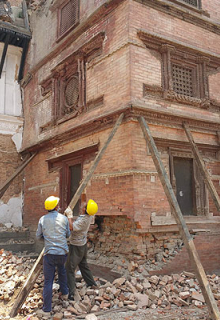Twelfth International Training Course (ITC) on Disaster Risk Management of Cultural Heritage
Place: Kyoto, Kobe and Kumano, Japan
Organized by:
Institute of Disaster Mitigation for Urban Cultural Heritage, Ritsumeikan University, in cooperation with UNESCO, ICCROM, ICOMOS/ICORP & ICOM
Supported by: Japanese National Institutes for Cultural Heritage (NICH)
Sub theme of ITC2017
Towards Integrated Protection of Immovable and Movable Cultural Heritage from Disasters
Cultural heritage is increasingly exposed to disasters caused by natural and human-induced hazards such as earthquakes, floods, fires, terrorism etc. Recent examples include Earthquakes in Central Italy and Myanmar in 2016, the Nepal earthquake in 2015, the Balkan floods in 2014 and ongoing conflicts in Syria and Yemen. These disasters not only affect the immovable heritage components such as monuments, archaeological sites and historic urban areas but also cause damage to the movable components that include museum collections and heritage objects that are in active use, such as religious and other artefacts of significance to the local community.
Both these movable and immovable components are exposed to various hazards that necessitate appropriate measures to reduce disaster risks. Also in the aftermath of a disaster, many architectural fragments of damaged or collapsed buildings need documentation, handling and storage similar to movable heritage collections. Therefore an integrated approach for movable and immovable heritage is needed for risk assessment of heritage sites as well as museums and its collections before, during and after a disaster situation.
Limited availability of human and financial resources also calls for closer coordination between professionals and institutions dealing with heritage sites, museums and the external agencies. Moreover, integrated disaster risk management involves appropriate mitigation and adaptation strategies to reduce various risks to movable and immovable heritage components, by taking into consideration their heritage values that are often interdependent. It is also important to recognize many examples of traditional knowledge evolved by communities through many cycles of trial and error. These examples demonstrate that movable and immovable cultural heritage can be an effective source of resilience against disaster risks and should be integrated into larger disaster risk management strategies.
Considering these issues and challenges, the 12th International Training Course will give special focus to Integrated Protection of Immovable and Movable Cultural Heritage from Disasters.
For more detail
Application Requirements
To apply
Applications should be E-mailed to dmuchitc@st.ritsumei.ac.jp
Please see the Guidelines for Application for more details.
Application deadline: 19 April 2017

